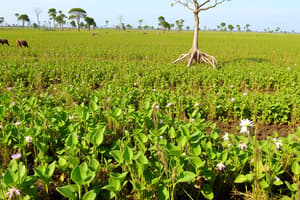Podcast
Questions and Answers
What characterizes a closed system in experiments?
What characterizes a closed system in experiments?
- It transfers both energy and matter.
- It does not allow for statistical testing.
- It operates without any boundaries.
- It transfers energy but no matter. (correct)
Climate change refers to a temporary alteration in the atmosphere.
Climate change refers to a temporary alteration in the atmosphere.
False (B)
What type of tests do scientists use to determine the probability in experiments?
What type of tests do scientists use to determine the probability in experiments?
statistical tests
An ______ system can transfer both energy and matter.
An ______ system can transfer both energy and matter.
Match the following terms with their definitions:
Match the following terms with their definitions:
What two factors combined determine impact in relation to climate change?
What two factors combined determine impact in relation to climate change?
Vulnerability is maximized by the sum of exposure, sensitivity, and adaptive capacity.
Vulnerability is maximized by the sum of exposure, sensitivity, and adaptive capacity.
What is a key characteristic of adaptation options in natural systems?
What is a key characteristic of adaptation options in natural systems?
What does adaptive capacity refer to in the context of climate change?
What does adaptive capacity refer to in the context of climate change?
The equation for vulnerability is _ + _ + _ = Vulnerability.
The equation for vulnerability is _ + _ + _ = Vulnerability.
Human intervention cannot facilitate adjustments to expected climate impacts.
Human intervention cannot facilitate adjustments to expected climate impacts.
What may be a consequence of human intervention in natural systems regarding climate impacts?
What may be a consequence of human intervention in natural systems regarding climate impacts?
Which statement best describes the focus of the changes in ecosystems as mentioned?
Which statement best describes the focus of the changes in ecosystems as mentioned?
Ecosystems are solely influenced by cultural systems.
Ecosystems are solely influenced by cultural systems.
Adaptation options in natural systems must consider their specific __________.
Adaptation options in natural systems must consider their specific __________.
What is the name of the author who wrote 'Pigs for the Ancestors'?
What is the name of the author who wrote 'Pigs for the Ancestors'?
Match the following aspects of climate options with their descriptions:
Match the following aspects of climate options with their descriptions:
What is the maximum amount of carbon emissions that can be allowed into Earth’s atmosphere?
What is the maximum amount of carbon emissions that can be allowed into Earth’s atmosphere?
The emphasis on biological survival relates more to populations than to the persistence of ______.
The emphasis on biological survival relates more to populations than to the persistence of ______.
Resilience only relates to environmental factors related to disasters.
Resilience only relates to environmental factors related to disasters.
Match the following terms with their appropriate descriptions:
Match the following terms with their appropriate descriptions:
What does resilience pertain to in relation to disasters?
What does resilience pertain to in relation to disasters?
Global emissions cannot exceed __________ billion tons of carbon into the atmosphere.
Global emissions cannot exceed __________ billion tons of carbon into the atmosphere.
Match the following terms related to emissions and resilience:
Match the following terms related to emissions and resilience:
What does the term 'adaptation' refer to in the context of disaster risk?
What does the term 'adaptation' refer to in the context of disaster risk?
The primary goal of disaster risk management is to prevent all hazardous events from occurring.
The primary goal of disaster risk management is to prevent all hazardous events from occurring.
What is meant by disaster risk reduction?
What is meant by disaster risk reduction?
The political dimensions of disaster risk management include the ability to __________ from the effects of hazards.
The political dimensions of disaster risk management include the ability to __________ from the effects of hazards.
Match the following components of disaster management with their descriptions:
Match the following components of disaster management with their descriptions:
Flashcards
Ecosystem Response
Ecosystem Response
How an ecosystem changes in reaction to outside factors.
Ecosystem vs. Social System
Ecosystem vs. Social System
Ecosystems focus on biological survival, while social systems focus on culture.
Biological Survival
Biological Survival
The survival of a living species or population.
Sociocultural Systems
Sociocultural Systems
Signup and view all the flashcards
Pigs for the Ancestors
Pigs for the Ancestors
Signup and view all the flashcards
Closed System
Closed System
Signup and view all the flashcards
Open System
Open System
Signup and view all the flashcards
Climate Change
Climate Change
Signup and view all the flashcards
Controlled Experiment
Controlled Experiment
Signup and view all the flashcards
Statistical Tests
Statistical Tests
Signup and view all the flashcards
Adaptation
Adaptation
Signup and view all the flashcards
Mitigation
Mitigation
Signup and view all the flashcards
Climate Change Impacts
Climate Change Impacts
Signup and view all the flashcards
Human Intervention
Human Intervention
Signup and view all the flashcards
Unintended Impacts
Unintended Impacts
Signup and view all the flashcards
Climate Change Sensitivity
Climate Change Sensitivity
Signup and view all the flashcards
Adaptive Capacity
Adaptive Capacity
Signup and view all the flashcards
Vulnerability
Vulnerability
Signup and view all the flashcards
Disaster
Disaster
Signup and view all the flashcards
Adaptation and Disaster Risk Reduction (DRM)
Adaptation and Disaster Risk Reduction (DRM)
Signup and view all the flashcards
Paradigms in DRM
Paradigms in DRM
Signup and view all the flashcards
Political Dimensions in DRM
Political Dimensions in DRM
Signup and view all the flashcards
System Adaptation
System Adaptation
Signup and view all the flashcards
Disaster Risk Reduction (DRR)
Disaster Risk Reduction (DRR)
Signup and view all the flashcards
Global Carbon Limit
Global Carbon Limit
Signup and view all the flashcards
Resilience (in Disasters)
Resilience (in Disasters)
Signup and view all the flashcards
Adaptation (to Climate Change)
Adaptation (to Climate Change)
Signup and view all the flashcards
Mitigation (of Climate Change)
Mitigation (of Climate Change)
Signup and view all the flashcards
Study Notes
Ecology and Human Interaction
- Ecology is the study of the economy, household, and organisms.
- Ecosystem models the cycle of energy and matter, including organic and inorganic entities.
- Organisms depend on energy and matter.
- Ecosystems describe how human populations influence and are influenced by their surroundings.
Ecosystem Stability
- Resilience measures a system's ability to change while maintaining its basic elements and relationships.
- Stability measures how quickly a system returns to equilibrium after disturbances.
- Systems with high resilience but low stability may experience continual change.
- Systems with high stability but low resilience may show little change in response to disturbances but can collapse suddenly.
Types of Ecosystems
- Natural Systems: Not noticeably altered by humans. Ecosystems such as mountains, lakes, and primeval forests are examples.
- Semi-natural Systems: Ecosystems altered by human activities but retaining significant natural elements. Examples include areas with traditional agricultural forms.
Artificial Ecosystems
- These are human-made systems with plants, animals, and people.
- Examples include zoos with artificial ecosystems replicating natural habitats.
Human Systems
- Families are the fundamental social unit with associated relationships.
- Organizations, random groups, or carefully constructed groups address short or long-term needs.
- Communities are the theory of relationships helping local populations meet daily requirements.
Ecosystem Models and Approaches
- Ecosystem-based models focus on the relationship between human populations and ecosystems.
- Social systems interact with the ecosystem and receive inputs from it.
- The human ecosystem model involves critical resources (biotic and abiotic), social systems, and their interactions.
Climate Change
- Climate change is a systematic change in the atmospheric conditions over multiple decades or more.
- Natural variation in climate occurs over months to decades.
- Greenhouse gases, such as carbon dioxide, methane, nitrous oxide, and black carbon, released during the Industrial Revolution caused and are causing climate change.
Climate Change Impacts
- Surface and ocean temperatures are rising.
- Glaciers and snowpack are losing mass.
- Sea levels are rising.
- Increased extreme weather events (storms, floods, droughts).
- Ocean acidification due to increased carbon dioxide absorption.
Adaptation and Vulnerability
- Adaptation is the ability of a system to adjust to climate change.
- Vulnerability is the system's predisposition to being negatively affected by climate change.
- Adaptive capacity is a system's ability to anticipate, recover, respond, and recover from threats.
- Factors influencing adaptive capacity include access to information, resources, flexibility, and willingness to adapt.
- Vulnerability assessments consider sensitivity and exposure in addition to adaptive capacity.
Studying That Suits You
Use AI to generate personalized quizzes and flashcards to suit your learning preferences.
Related Documents
Description
Test your understanding of ecology and the complex interactions between human populations and their environments. Explore concepts such as ecosystem stability, resilience, and the types of ecosystems that exist in our world. This quiz will challenge your knowledge of how human actions influence ecological systems.




